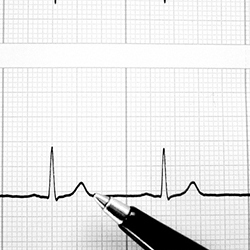Matters of the Heart: They Don’t Miss a Beat
Your pulse is racing and you can feel your heartbeat resonating through your chest. The emergency room doctors hurriedly push you down the cold hallway, trying to hide the panic on their faces. When a patient is lying in the hospital with a serious heart condition, the last thing they need to worry about is the extent of the doctor’s training. Therefore, it is vital for doctors to practice their techniques before interacting with live patients. A team of bioengineering Creative Inquiry students, led by Dr. David Kwartowitz, is working to create an electrocardiogram (EKG) simulation device based on biological signals in the human body. They plan to use the device for training and evaluation purposes.
An EKG is the typical method used to collect data about electrical activity in the heart. Patients are often closely monitored during surgeries to ensure a healthy beat is maintained. However, it is necessary to have a working system that collects the data from the EKG and sends it to a computer for further analysis. This information can be used to diagnose a number of health issues, including heart attacks and heart arrhythmias – which are caused by problems in the electrical impulses that create heartbeats. These issues cause a fast, slow or irregular pulse in the patient.
Amanda Nguyen, a junior on the team, explained, “Working on the EKG Simulation and Modeling Creative Inquiry project has provided me the invaluable opportunity to gain hands-on experience with designing electrical circuits. During the process I learned a lot about the practicalities of electrical circuit design that I would not have been able to gain otherwise.”
The Creative Inquiry team focused on two main goals. First, they designed a system to process the EKG signals. Then, they created a human-like dummy for the simulation. The materials used in the dummy were produced to resemble the texture of human tissue, which creates a realistic environment when operating the EKG system.
This EKG simulation will be used for both teaching and training purposes. The simplistic yet realistic nature of the system allows it to be utilized in a number of settings, from elementary schools to medical training evaluations. As children are taught about the human body and EKG signals, they can visualize the process using the interactive dummy. The kids will be able to physically manipulate the simulation in a hands-on approach to understand exactly how an EKG works. They will also be able to listen to hearts that have abnormalities, like arrhythmias, to engage them in the material and help them better grasp the concept.
Professional medical trainees can utilize the simulation due to the realistic and reliable nature of the system. Doctors will be able to learn, experiment, and evaluate their work on the model. The team created an EKG unit that efficiently filters out electrical potential changes in the heart and amplifies them, which allows doctors to better understand what is taking place in the patient from a safe distance. Nguyen noted, “It has been incredibly rewarding to be able to apply the knowledge I have gained in lecture to produce a working EKG.”
Through creating an advanced electrocardiogram system, this Creative Inquiry team will impact both the educational and medical fields. This versatile project benefits a wide array of people in a variety of situations. The team is breaking down the science of simulations – one heartbeat at a time!



